
Last year, a group of past, present, and would-be elected officials co-signed a statement in support of stronger American labor unions.
“Well-functioning private-sector worker organizations are vital mediating institutions for establishing stronger bonds among workers, facilitating mutual aid, and affording meaningful participation in the public square,” read the statement. “Giving workers a seat at the table also fosters shared understanding and mutual respect between workers and the managers, owners, and political leaders who have become socially and economically isolated from the American mainstream.”
 These ideas are nothing new to the American labor movement, but the signatories are. They include former U.S. Senator and former U.S. Attorney General Jeff Sessions, current U.S. Senator Marco Rubio, and U.S. Senate hopeful J.D. Vance, among others. All conservative Republicans and, as such, historically hostile to labor.
These ideas are nothing new to the American labor movement, but the signatories are. They include former U.S. Senator and former U.S. Attorney General Jeff Sessions, current U.S. Senator Marco Rubio, and U.S. Senate hopeful J.D. Vance, among others. All conservative Republicans and, as such, historically hostile to labor.
The statement signals, if not a realignment in American politics, a softening of hard terrain that saw labor as a staunchly loyal and powerful constituency of the Democratic Party going back to Franklin Delano Roosevelt. In 1992, Democrats enjoyed a 31-point advantage to Republicans when it came to voting among union households. By the time Donald Trump came along in 2016, that advantage had closed to 8 points. When viewed through a political lens, Sessions and Rubio’s statement is part of a broader strategy by national Republicans to recast the GOP as the party of working people. But beyond electoral politics, this tectonic shift bodes well for perhaps a more transformative opportunity in American life: immigration reform.
 A former Capitol Hill staffer, speaking to us on background, foresees potential for an immigration reform coalition among Democrats, Trump voters, and organized labor, with union leadership in a power-broker role between Democrats and Republicans.
A former Capitol Hill staffer, speaking to us on background, foresees potential for an immigration reform coalition among Democrats, Trump voters, and organized labor, with union leadership in a power-broker role between Democrats and Republicans.
To understand how this dynamic could play out, it is important to first understand the role that unions play in immigration policy, and how labor’s position on undocumented workers has evolved over the years.
IRCA
American workers have a long history of hostility toward immigrant workers. Passage of the country’s first piece of immigration legislation, The Chinese Exclusion Act of 1882, designed to keep Chinese laborers out of the country, was driven by native-born Americans who journeyed to California and viewed the growing Chinese population in the west as a threat to their access to mining claims and economic opportunities. That sense of threat, however misguided, endured across the 20th century as waves of immigrants arrived during two world wars, the social upheaval of the 1960s, and years of turmoil in Eastern Europe.
“Organized labor played a pivotal role in the passage of the civil rights bills of the ’60s,” says Charles Kamasaki, a senior advisor at UnidosUS, the country’s largest Latino advocacy organization. “In some ways, they controlled the purse strings of a lot of civil rights organizations — they were very large contributors to the Leadership Conference on Civil Rights.” But the unions did not often see eye-to-eye with the civil rights leaders when it came to immigration policy. Kamasaki notes, “When there was a debate [on an immigration issue] within the Leadership Conference, essentially with labor on one side and Latino civil rights organizations on the other side, it was pretty clear that labor was going to win that debate.”
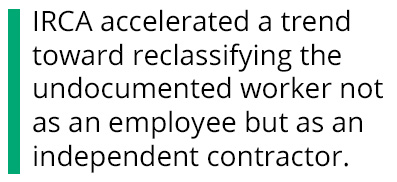
The last time the country passed comprehensive immigration reform — the Immigration and Control Act of 1986, or IRCA — Kamasaki was a key negotiator and recalls that the divide in policy between civil rights activists and unions on immigration matters was still a source of tension long after their collective success on civil rights legislation in the ’60s.
IRCA tried to keep undocumented workers out of the workforce by putting penalties in place for employers who hired them. Latino organizations like UnidosUS (known at the time as the National Council of La Raza) were against these penalties, unconvinced of their efficacy, but the AFL-CIO put its full support behind them. “The prevailing economic theory of the day was that labor surpluses were inherently bad,” says Kamasaki, explaining labor’s position. “Immigration increased the pool of labor, ergo, immigration is bad. And it was pretty simple at one level.”
In the long run, the penalties did not prove effective at stopping the undocumented population from growing. Employers had to “knowingly” hire these workers and proving pre-knowledge is a tall legal order in a sector where fraudulent documentation was common. IRCA accelerated a trend toward reclassifying the undocumented worker not as an employee but as an independent contractor. Mark Erlich, a former union leader who is now a fellow at Harvard University’s Labor and Worklife Program, put it like this: “More employers started saying, ‘Well, if I don’t treat these people as employees, but if I treat them as independent contractors, or if I go through labor brokers to provide workers for me, then I’m not employing them and I’m not in violation of the law.’”
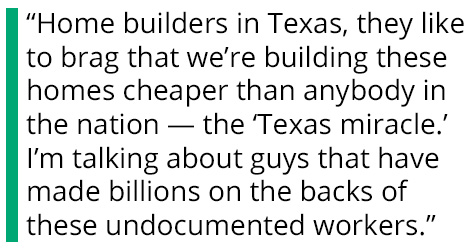 Since the passage of IRCA, labor brokers, middle-men who often pair employers with undocumented workers, have increasingly become a vital part of certain industries, particularly the building trades. “One of the unintended consequences of the 1986 act,” says Erlich, “was that it encouraged the growth of independent contracting and [covert] cash compensation, which resulted in a tremendous amount of wage theft — from not getting a minimum wage, not getting overtime, to sometimes not even getting paid at all.”
Since the passage of IRCA, labor brokers, middle-men who often pair employers with undocumented workers, have increasingly become a vital part of certain industries, particularly the building trades. “One of the unintended consequences of the 1986 act,” says Erlich, “was that it encouraged the growth of independent contracting and [covert] cash compensation, which resulted in a tremendous amount of wage theft — from not getting a minimum wage, not getting overtime, to sometimes not even getting paid at all.”
Stan Marek, CEO of Marek, a Houston-based commercial builder since 1938 with more than 400 clients today, says employment in the construction industry became dominated by the independent contractor model. “The home builders in Texas,” he says, “their argument was: ‘Look, workman’s comp, that’s a lawyer thing, and if they get hurt, they can go to the ER. Overtime? If they want to work, we don’t need to pay them overtime. Self-employment taxes? Nobody enforces that, so they don’t pay taxes. Home builders in Texas,” he adds, “they like to brag that we’re building these homes cheaper than anybody in the nation — the ‘Texas miracle.’ I’m talking about guys that have made billions on the backs of these undocumented workers.”
In spite of this insurgence of “independent contractor” status as an evasive device for undocumented workers, organized labor remained focused for many years after IRCA’s adoption on penalties for employers as as a way to deter the hiring of undocumented workers. This union position was still in place when the follow-up immigration bill to IRCA, the Immigration Act of 1990, worked its way through Congress and into law.
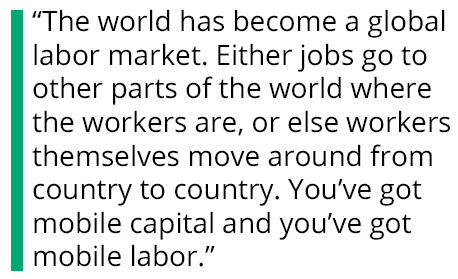 Below the surface a shift was playing out with organized labor. Waves of migration from Central America during the late ’80s and ’90s began bringing more undocumented workers into the country who ended up as domestics and busboys, short-order cooks and janitors. They were often hired informally by employers who paid cash and looked the other way, or they were hired with falsified documents. “Many of them,” notes Kamasaki, “became union members [in spite of their undocumented status] and they were agitating for changes and protections.” While many of the established manufacturing and trade unions were hesitant to engage these workers, the burgeoning service sector unions were much more active with outreach and less concerned with the immigration status of their members.
Below the surface a shift was playing out with organized labor. Waves of migration from Central America during the late ’80s and ’90s began bringing more undocumented workers into the country who ended up as domestics and busboys, short-order cooks and janitors. They were often hired informally by employers who paid cash and looked the other way, or they were hired with falsified documents. “Many of them,” notes Kamasaki, “became union members [in spite of their undocumented status] and they were agitating for changes and protections.” While many of the established manufacturing and trade unions were hesitant to engage these workers, the burgeoning service sector unions were much more active with outreach and less concerned with the immigration status of their members.
NAFTA
In the 1990s, union members sensed that Democratic-led trade agreements such as NAFTA had hijacked many of their jobs. NAFTA did, after all, allow American manufacturers to move production to Mexican factories, or maquiladoras, where labor was cheaper. This shift of manufacturing over the border coincided with a narrowing of the gap between union support for Democratic and Republican candidates. “The world has become a global labor market,” says Erlich, who points out that this globalized labor market functions in two ways. “Either jobs go to other parts of the world where the workers are, or else workers themselves move around from country to country. You’ve got mobile capital and you’ve got mobile labor.”
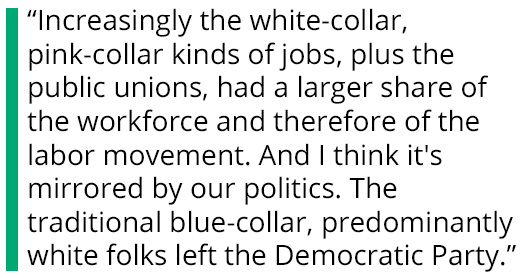 NAFTA shaped early union anxiety about globalization and anger at movement of jobs out of the country. By the turn of the century this anxiety and anger were being reinforced by a growing immigrant workforce coming into the U.S. “With manufacturing and trade jobs,” says Kamasaki, “the old traditional blue-collar jobs, shrinking as a portion of the economy, the unions representing those workers also shrank in terms of influence within organized labor. Increasingly the white-collar, pink-collar kinds of jobs, plus the public unions, had a larger share of the workforce and therefore of the labor movement. And I think it’s mirrored by our politics. The traditional blue-collar, predominantly — not exclusively, but predominantly — white folks left the Democratic Party.”
NAFTA shaped early union anxiety about globalization and anger at movement of jobs out of the country. By the turn of the century this anxiety and anger were being reinforced by a growing immigrant workforce coming into the U.S. “With manufacturing and trade jobs,” says Kamasaki, “the old traditional blue-collar jobs, shrinking as a portion of the economy, the unions representing those workers also shrank in terms of influence within organized labor. Increasingly the white-collar, pink-collar kinds of jobs, plus the public unions, had a larger share of the workforce and therefore of the labor movement. And I think it’s mirrored by our politics. The traditional blue-collar, predominantly — not exclusively, but predominantly — white folks left the Democratic Party.”
Unions were becoming more diverse in their make-up and in their interests. “When I worked for the AFL-CIO,” says Sonia Ramirez, a former lead lobbyist for the behemoth federation of unions, “I represented everybody from Border Patrol agents, construction workers, service sector, hospitality workers, a whole array of folks who have different entries into this conversation. They have different priorities and perspectives, so to craft policy that everybody is pleased with and feels represented by is very, very challenging.”
Private sector unions were beginning to diversify in the 1990s, most notably with more service sector employees; but still, the overall share of American workers who belonged to private sector unions was shrinking. This came as public sector unions began growing, gaining more of a leadership voice. Today, the union membership rate of public sector workers is five times higher than that of private sector workers, 34.8 percent to 6.3 percent.
 The public sector workforce traditionally has been more diverse, largely due to potent affirmative action programs, not just in the federal government, but in state and local governments. Kamasaki suggests that “one could attribute part of the growing sympathy for immigrants — and for that matter civil rights and racial justice issues writ large — to the growth in public sector union membership.” He says the flip-side is that the largely white, often rural trade crafts and industrial workers who historically had more antipathy towards immigrants, “didn’t just leave the progressive coalition — many of them lost their jobs or certainly lost their union protections. Just as the demography of the country was changing, the demography of the workforce was changing. To a large extent that affected the demography and the constituency of organized labor. And evolution on policy positions over time reflected those shifts.”
The public sector workforce traditionally has been more diverse, largely due to potent affirmative action programs, not just in the federal government, but in state and local governments. Kamasaki suggests that “one could attribute part of the growing sympathy for immigrants — and for that matter civil rights and racial justice issues writ large — to the growth in public sector union membership.” He says the flip-side is that the largely white, often rural trade crafts and industrial workers who historically had more antipathy towards immigrants, “didn’t just leave the progressive coalition — many of them lost their jobs or certainly lost their union protections. Just as the demography of the country was changing, the demography of the workforce was changing. To a large extent that affected the demography and the constituency of organized labor. And evolution on policy positions over time reflected those shifts.”
In a way that both reflects and augments the impact of this demographic shift, public sector unions don’t confront the issue of undocumented workers in the way public sector unions do. Because it’s nearly impossible to secure a public sector job without valid proof of citizenship, hiring undocumented workers is not a significant labor market factor. This makes it easier for public sector employees to embrace “growing sympathy for immigrants,” as Kamasaki puts it.
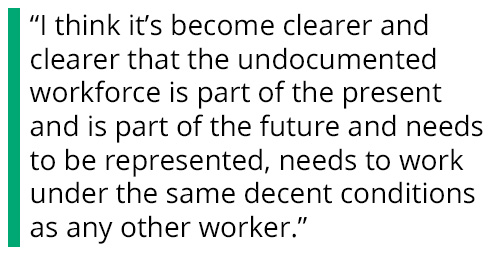 The growth of the undocumented workforce, and the challenges presented by that growth, have had their impact almost entirely in private sector industries — and none more so than construction and agriculture. According to the Pew Research Center, 29 percent of the agricultural workforce is comprised of immigrants, with 14 percent undocumented, and 25 percent of construction industry workers are immigrants, with 12 percent undocumented. By comparison, about 14 percent of the food industry workforce (production, processing, distribution, and retail), is made up of immigrants, and approximately 10 percent are undocumented.
The growth of the undocumented workforce, and the challenges presented by that growth, have had their impact almost entirely in private sector industries — and none more so than construction and agriculture. According to the Pew Research Center, 29 percent of the agricultural workforce is comprised of immigrants, with 14 percent undocumented, and 25 percent of construction industry workers are immigrants, with 12 percent undocumented. By comparison, about 14 percent of the food industry workforce (production, processing, distribution, and retail), is made up of immigrants, and approximately 10 percent are undocumented.
While only service sector unions, like those in the food industry, began doing any significant outreach to undocumented workers, leaders in more traditional unions, like the building trades, did, in fact, begin changing their view on central immigration issues. “Having an exploitable segment of the workforce,” says Sonia Ramirez, “a segment that is undocumented and stripped of certain labor rights, creates a parallel labor market and it puts downward pressure on wages because now you have a leak, you have the opportunity to recruit and hire folks that have fewer labor rights. Supporting the right to legal status for these workers really is about ensuring a functioning labor market [on a more level playing field] and ensuring that there’s not the exploitation of workers that impacts everyone.” But, as Ramirez acknowledges, it has been a slow process bringing rank-and-file members around to this point of view — and it remains an ongoing effort.
2007
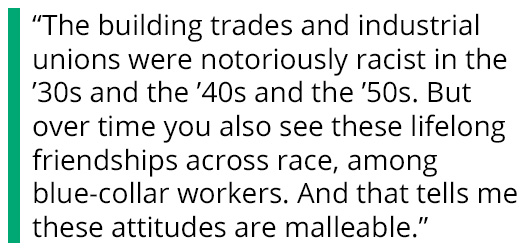 In the late 1990s and early 2000s, when Mark Erlich was the director of organizing for the New England Carpenters Union, he would send teams out to job sites across the region, trying to connect with non-union workers to see how they were being treated and paid. In addition to identifying organizing opportunities and recruiting new members, the site visits helped the union maintain a clear picture of the overall labor market in the area.
In the late 1990s and early 2000s, when Mark Erlich was the director of organizing for the New England Carpenters Union, he would send teams out to job sites across the region, trying to connect with non-union workers to see how they were being treated and paid. In addition to identifying organizing opportunities and recruiting new members, the site visits helped the union maintain a clear picture of the overall labor market in the area.
Erlich insisted on weekly calls so he could get direct reports from the field, and he still remembers the first time his best organizer rang to say he was running into issues talking to non-union carpenters. “He tells me, ‘I just can’t do it,” recalls Erlich. “I said, ‘What do you mean you can’t?’ He said, ‘None of them speak English.’ That was the first time we really encountered that on a big, commercial project.”
It was a report Erlich would soon hear from other organizers and, in a matter of a few years, it became the prevailing report. “Around 2000,” he says, “when I first started getting word about Spanish-speaking workers, the initial reaction of a lot of unions in the building trades was hostile and was, ‘They’re taking our jobs, let’s call up immigration enforcement.’”
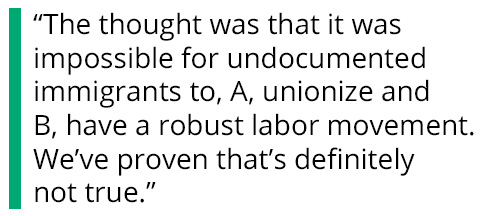 But Erlich and other union leaders soon came to understand that no matter how many calls they made to immigration enforcement, it wouldn’t change the fundamentals of globalized capitalism. As long as competition was driving U.S. employers to routinely pursue the cheapest possible labor, then undocumented workers would continue to immigrate to our country. “I think it’s become clearer and clearer,” says Erlich, “that the undocumented workforce is part of the present and is part of the future and needs to be represented, needs to work under the same decent conditions as any other worker. But I would say that the evolution [of union members to accept this conclusion] is still incomplete.”
But Erlich and other union leaders soon came to understand that no matter how many calls they made to immigration enforcement, it wouldn’t change the fundamentals of globalized capitalism. As long as competition was driving U.S. employers to routinely pursue the cheapest possible labor, then undocumented workers would continue to immigrate to our country. “I think it’s become clearer and clearer,” says Erlich, “that the undocumented workforce is part of the present and is part of the future and needs to be represented, needs to work under the same decent conditions as any other worker. But I would say that the evolution [of union members to accept this conclusion] is still incomplete.”
Completing this evolution, Erlich says, is about getting rank-and-file members to shift their ire from foreign workers to the employers who hire them — and to begin understanding how exploitation of the vulnerable status of some workers affects all workers, regardless of where they are born.
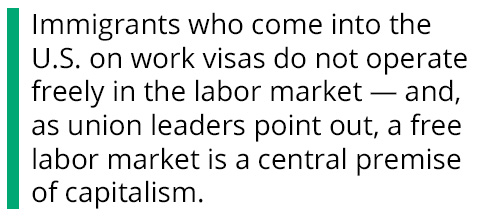 Sometimes this process is more complicated than communicating just the economic imperatives. Cultural issues also play a part. “People will say, ‘Ah, those guys don’t speak English,’” says Kamasaki. “That’s actually not what they’re saying. Because for any of the jobs that require communication with someone else, people actually do speak English, or at least speak it well enough. That’s actually not what people are complaining about. They’re complaining [about workers who] choose to speak Spanish [with their co-workers], and that’s a whole different thing. Quite often concerns about race really influence perceptions. You do hear about labor market competition issues, but really when you probe deeper, it’s a lot more replacement theory type stuff. It’s more, ‘I used to be at the top of the heap here, and these guys are coming after my status.’ And I think that’s what really concerns some of the more traditional [union] members.”
Sometimes this process is more complicated than communicating just the economic imperatives. Cultural issues also play a part. “People will say, ‘Ah, those guys don’t speak English,’” says Kamasaki. “That’s actually not what they’re saying. Because for any of the jobs that require communication with someone else, people actually do speak English, or at least speak it well enough. That’s actually not what people are complaining about. They’re complaining [about workers who] choose to speak Spanish [with their co-workers], and that’s a whole different thing. Quite often concerns about race really influence perceptions. You do hear about labor market competition issues, but really when you probe deeper, it’s a lot more replacement theory type stuff. It’s more, ‘I used to be at the top of the heap here, and these guys are coming after my status.’ And I think that’s what really concerns some of the more traditional [union] members.”
By 2000 the AFL-CIO had officially moved away from support for employer sanctions. It was clear that that policy had failed to achieve its goal of reducing undocumented immigration and the unions began a shift towards support for more open immigration policies, including granting legal status to undocumented workers. “There were still a number of leaders within organized labor,” says Kamasaki, “who were committed to restriction. Like anything else with a diversity of views, it wasn’t a sudden 180-degree turn. It was more gradual over time. It takes time to change those views, it takes work, it takes effort. The building trades and industrial unions were notoriously racist in the ’30s and the ’40s and the ’50s. But over time you also see these lifelong friendships across race, among blue-collar workers. And that tells me these attitudes are malleable.”
A defining moment came in 2005 when a number of unions broke away from the AFL-CIO to form a “Change to Win Coalition.” Most notably, this included the Service Employees International Union (SEIU) — janitors, hotel workers, restaurant workers — which had substantially more Latinos among its membership, and these rank-and-file members were critical of some of the more anti-immigration stances taken by the AFL-CIO over the years. The new leadership at the SEIU wanted to reckon more directly with decreasing union membership and focus on new ways to encourage organizing, which included bringing more Latino workers — in some cases undocumented — into their ranks. Christian Ramirez, the SEIU Policy Director in the state of California, says, “Back then the thought was that it was impossible for undocumented immigrants to, A, unionize and B, have a robust labor movement. We’ve proven that’s definitely not true.”
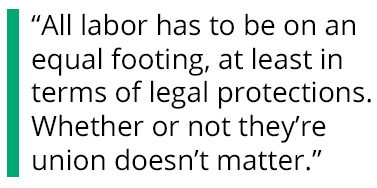
By the time the proposed Comprehensive Immigration Reform Act of 2007 began to gain ground in Congress, unions were in the middle of these fundamental shifts, and it muddled their position on the bill. “I think labor played a somewhat equivocal role in 2006, 2007,” says Kamasaki. “I think they were generally fine with and supportive of legalization [of most of the undocumented].” But, noted Kamasaki, the 2007 bill also included stronger enforcement measures, which helped bring in more rounded union support.
By then the real fight had shifted to the issue of foreign-worker visas. These visas are granted for a finite amount of time, designated for particular industries and made available to employers who can demonstrate a shortage of American workers. Indeed the country has been confronting a labor shortage for years now. Before the pandemic, the U.S. experienced two straight years with the number of job openings outpacing the number of people looking for jobs. In the summer of 2019, for instance, there were 7.4 million openings but only 6 million people looking for work. Covid-19 briefly threw those statistics into chaos but the dynamic has already been restored, as the U.S. economy re-opens and employers once again compete for workers, particularly in blue-collar and manual labor jobs.
In spite of this imbalance of demand over supply in recent years, unions have remained steadfastly opposed to foreign-worker visas. “Having a guest-worker system or a two-tier system, in some ways institutionalizes a form of apartheid in the workplace,” says Mark Erlich.
There are dozens of foreign-worker visa categories that address an array of industries and pay rates, both for manual laborers and workers with advanced degrees. Perhaps the best-known is the H2B visa, which is used to fill white-collar jobs, notably in Silicon Valley, where employers have been criticized by the union community for not fully demonstrating that American-born workers could not be found.
Immigrants who come into the U.S. on work visas do not operate freely in the labor market — and, as union leaders point out, a free labor market is a central premise of capitalism. While each visa has its own parameters, many identify the worker as an independent contractor, not an employee, which strips the visa holder of rights afforded to employees including health benefits and workers’ comp. The hazardous parallel with the rise of independent contracting by undocumented workers is clear. Also, because these visas are temporary, they cut into the workers’ long-term prospects for increasing their wages. Most significantly, immigrants who enter the country on a work visa are often allowed to work only for the employer who sponsored the visa. A worker who quits a temporary-visa job must, in most cases, leave the country. This has a negative effect on competition in the labor market and, ultimately, wages for all workers.
“Temporary workers create a challenge,” says Sonia Ramirez. “They can solve in limited ways shortages that truly exist. Those tend to be seasonal, like agriculture and hospitality, or in very targeted places, like remote areas where employers can’t recruit folks because of limitations on housing or other issues.”
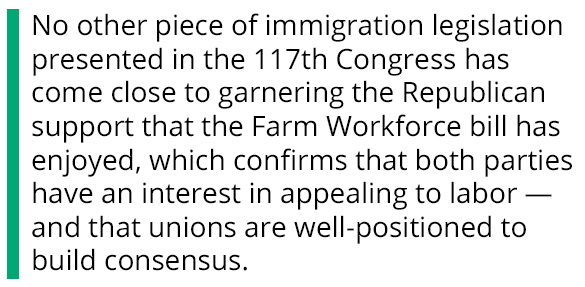
But Ramirez says concerns about foreign-worker temporary visas remain in the organized labor community even when a need for foreign workers is clearly demonstrated. “Regarding a minimum wage, overtime, anti-discrimination — the basics of employment law — it seems to me that these need to be available to everybody,” she says. “Having a guest-worker program where people are not employees, you’re always going to have a drag on standards in an industry. All labor has to be on an equal footing, at least in terms of legal protections. Whether or not they’re union doesn’t matter. Every worker should have the basic protections that we have spent a century developing in this country under the Fair Labor Standards Act and under the National Labor Relations Act.”
In the end, the 2007 comprehensive reform bill did not pass both houses of Congress. Charles Kamasaki says some of that is because of the union position on foreign-worker visas. “There are people including former and current staff here at UnidosUS,” he says, “who believe that when the proposed ‘grand bargain’ went down in flames in 2007, organized labor played a role and was not fully supportive of the foreign-worker-visa component. That’s my view as well. I will also say that anytime you have these very large complex bills, it’s not hard to find something you’re against.”
2013
In order to bring more traditional union members around to more generous immigration policies, union leaders have more recently tried to strike a balance between pressing for more border security and legal acceptance of the workforce that is already in the country. It’s this balanced approach that positions unions to communicate effectively with both political parties.
Take, for instance, Resolution 11, which was adopted by the AFL-CIO at a 2009 conference and remains in place today as a framework for immigration reform. The resolution not only puts forward ideas for guaranteeing that all workers in the country are treated equally, such as legalizing the undocumented workforce and reforming guest-worker programs, but it also puts forward ideas for controlling the future flow of workers, such as stronger and more dignified border enforcement and a reliable immigration status verification system for employers.
By the time efforts were underway to pass the Border Security, Economic Opportunity and Immigration Modernization Act of 2013, most of labor was fully behind the idea of legalizing the undocumented workforce. “I think labor was not entirely, but almost uniformly and enthusiastically supportive of the [legalization features of the 2013] Gang of Eight bill,” says Kamasaki, while noting the importance of remembering that the organized labor movement always features many different voices.
Nevertheless, the foreign-worker visa remained a sticking point. After the Senate passed the bill and it stalled out because of stiff resistance from GOP immigration restrictionists in the House, the unions did not have a unified voice with which to try to push the bill through and, ultimately, it was shelved.
TODAY
In March of this year, U.S. Senator Marco Rubio penned an op-ed in USA Today, voicing support for the unionization effort by Amazon workers in Alabama: “The move [to unionize] comes after a banner year for Amazon thanks to the COVID-19 lockdowns. But even after historic market gains, its corporate leadership fears the prospect of its workers having an increased say in working conditions, so it’s looking to crush the union vote.”
A Republican supporting a unionizing effort is rare, to say the least. But the senator was full-throated: “Here’s my standard,” he wrote, “When the conflict is between working Americans and a company whose leadership has decided to wage culture war against working-class values, the choice is easy — I support the workers. And that’s why I stand with those at Amazon’s Bessemer warehouse today.”
When asked if he thinks the Republican play for more union votes has a real chance, Charles Kamasaki says, “It’s hard to tell. I think it would be a very healthy development for these issues to be played out less along purely partisan lines. As a Latino advocate, I would love for Republicans to be competing for the Latino vote, which they are. And I wish they were doing it a little bit more.”
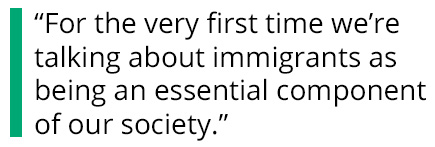
When it comes to voting records, there have already been trace amounts of bipartisan support for giving legal status to undocumented workers. The Farm Workforce Modernization Act (FWMA) was introduced in March and 13 Republicans co-sponsored it; when the bill passed the House later that month, 30 Republicans voted for it. FWMA would not only provide a pathway to legal status for undocumented agricultural workers but also set out a plan for reforming foreign-worker visas in the industry.
No other piece of immigration legislation presented in the 117th Congress has come close to garnering the Republican support that FWMA has enjoyed, which confirms that both parties have an interest in appealing to labor — and that unions are well-positioned to build consensus.
Christian Ramirez characterizes in blunt terms the conditions that have made this bipartisan support of FWMA possible: “The agricultural industry understands that without having a way to adjust status for their workers, it’s going to simply collapse. Undocumented immigrants pick our crops. These are not just workers, these are full-blown members of our society who have, in some cases, been here for generations.”
Ramirez says he was encouraged by a May 12 hearing, “The Essential Role of Immigrant Workers in America,” convened by the Senate Subcommittee on Immigration, Citizenship and Border Safety. “They were having a conversation about acknowledging workers, regardless of their immigration status, as essential workers, essential to the economy, essential to getting us through the pandemic. I think that that is perhaps the most important political shift in Congress that I’ve seen. It hasn’t turned into legislative action but I think it’s an important paradigm shift that we should uphold and uplift. For the very first time we’re talking about immigrants as being an essential component of our society.” Ramirez’s optimism is tempered by his awareness that in spite of this “paradigm shift” by labor and the bipartisan support for FWMA in the House, nothing major in the immigration realm has yet “turned into legislative action” in the Biden era and success in the Senate is still a reach.
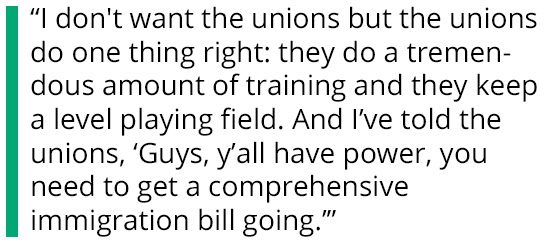 Stan Marek, the Texas construction contractor and immigration reformer, does not support unions, categorically, but agrees with Ramirez that the undocumented population is a problem begging for a forthright solution. “During COVID,” he says, “the governor here in Texas said, ‘Okay, all you construction workers are essential.’ And then a lot of people said, ‘Well, let’s get them legal status, not a path to citizenship, just legal status so we can ID and tax them.’ But nobody wants to mess with it. We’ll let them work, we’ll let them be in the neighborhood, do your yards. Yeah, your maid’s illegal but keep her. The people cooking your food in the restaurant are illegal and the people that built your house are illegal and people cleaning the hospital beds are illegal but let’s just leave it like that, it’s a good deal for all of us — that’s the attitude.”
Stan Marek, the Texas construction contractor and immigration reformer, does not support unions, categorically, but agrees with Ramirez that the undocumented population is a problem begging for a forthright solution. “During COVID,” he says, “the governor here in Texas said, ‘Okay, all you construction workers are essential.’ And then a lot of people said, ‘Well, let’s get them legal status, not a path to citizenship, just legal status so we can ID and tax them.’ But nobody wants to mess with it. We’ll let them work, we’ll let them be in the neighborhood, do your yards. Yeah, your maid’s illegal but keep her. The people cooking your food in the restaurant are illegal and the people that built your house are illegal and people cleaning the hospital beds are illegal but let’s just leave it like that, it’s a good deal for all of us — that’s the attitude.”
Marek sees the issue of fair treatment for all workers as a consensus builder when it comes to immigration policy. “I don’t want the unions,” he says, “but the unions do one thing right: they do a tremendous amount of training and they keep a level playing field. And I’ve told the unions, ‘Guys, y’all have power, you need to get a comprehensive immigration bill going.’”
###
Read More:






